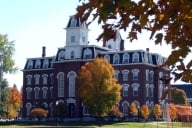You have /5 articles left.
Sign up for a free account or log in.
The 450 miles have often seemed insurmountable.
The stretch of mostly rural landscape that separates Reno and Las Vegas, Nev., is emblematic of the distant and fractured relationship that has long existed between the state’s two largest universities. But higher education leaders now say the time has come for the University of Nevada at Reno and the University of Nevada at Las Vegas to play nice.
While they may have been historical competitors, UNLV and Reno are viewed as key players in a new effort to reform the state’s troubled health care system. The University of Nevada Health Sciences System, designed about two years ago to expand health care offerings for the state's rapidly growing population, aims to pool the collective resources of Nevada's eight colleges and universities, health care professionals and the private sector.
The formation of the system has required a new level of strategic thinking, and a substantial checking of egos. As evidenced by recent developments at two fledgling public health programs in Reno and Las Vegas, the leaders of both universities appear to be accepting that they’ll have to work together. There is a growing acceptance that Nevada simply doesn’t have the money to form two fully accredited, stand-alone schools of public health.
It is uncommon -- if not unprecedented -- for a state with Nevada's population of about 2.5 million people to have two public health schools. Furthermore, recent declines in state revenues hardly poise Nevada to fund expensive new programs. The Nevada System of Higher Education is facing a 14 percent budget cut, which would translate into a $96.5 million reduction in funding for the 2009-2011 biennium.
“We are a small state, so I think it’s going to be difficult to justify two full schools of public health,” says Maurizio Trevisan, who works under the chancellor as head of the emerging health sciences system. “Second, I think by working together we can be more responsive to the needs of the state.”
Instead of seeking full accreditation for both schools at UNLV and Reno, university officials will pursue a more modest goal. They plan to vie for the accreditation of individual programs within the respective schools, an à la carte strategy that requires fewer faculty hires under standards set by the Council on Education for Public Health. The council, an independent nonprofit agency, is recognized by the U.S. Department of Education to accredit public health schools.
By agreeing to accredit individual programs -- as opposed to two entire schools -- leaders of UNLV and Reno are indicating a willingness to focus on specialization instead of duplication. To that end, officials at both institutions now say they’re open to the concept of joint degree programs.
“I think the president and the provost, all of us are in agreement,” said John McDonald, Reno’s vice president of health sciences. “We all agree that it does not make intellectual and financial sense [to have two separate schools].”
A History of Tension
The current presidents of UNLV and Reno, who were appointed after the two public health programs were established in 2004, are viewed by many as more open to working together than their predecessors had been, according to several officials interviewed for this article.
Tensions between the two universities can be traced to their roots. UNLV was founded in 1951 as an extension program for Reno, which retains its flagship status even as the population in Las Vegas -- more than 570,000 -- now doubles that of Reno. This history has sometimes created conflict, with the more established institution -- Reno -- and the upstart university in the emerging population center -- Las Vegas -- both pleading their cases for a greater share of resources.
In 2004, Jim Rogers, the outspoken chancellor of Nevada’s system, called on UNLV and Reno to end their “senseless war.”
“The head-to-head combat between UNLV and UNR is nothing less than destructive of both and destroys the confidence of the public,” Rogers wrote to the Board of Regents.
Four years have passed since the Rogers memo, and some Nevada leaders are now declaring that a successful truce -- albeit perhaps a fragile one -- has finally been brokered in the long civil war that pitted North against South. If that’s indeed the case, the timing is apropos. Nevada faces what some are describing as a unique health care crisis, and cooperation across higher education is viewed as an important part of the solution.
With its population growing at a phenomenal pace, Nevada ranks 46th in the nation in the ratio of doctors to residents, according to a 2007 report from the United Health Care Foundation. The foundation also ranks the state 39th in overall health, an indication that physician and nursing shortages have hampered treatment and preventative care.
A Hopeful Development
Higher education officials in Nevada are touting recent collaboration between Reno, UNLV and Nevada State College as an example of how an integrated health sciences system might work. The three institutions are pooling resources to build a high-tech laboratory in Las Vegas, where students will train on “SimMan” mannequins that serve as advanced patient simulators.
It’s worth noting that this new facility, which comes with a $28 million price tag, wasn’t born from a massive strategic plan or even the report of a faculty committee. It all started in the back of a taxi cab. Carolyn Yucha, a UNLV dean, recalls riding in a cab through Washington, D.C., when she and the head of nursing at Nevada State started discussing their mutual need for a simulation lab. The two surmised they’d have a better chance of getting the lab funded if they worked together and got Reno interested as well.
“We said if all three schools said, ‘this is what we want to do,’ we’d have clout,” recalls Yucha, dean of both UNLV’s School of Nursing and School of Allied Health Sciences.
Connie Carpenter, dean of nursing at Nevada State, says she’s never noticed any barriers when trying to work with other colleges and universities across the state.
“I just didn’t see it, except that people would talk about it,” says Carpenter, who has been in Nevada six years. “I know in the past it has been a political thing.”
Trevisan, who became executive vice chancellor of the health sciences system eight months ago, says it will be imperative for universities and colleges to make similar partnership proposals in the coming years. The Legislature approved about $127 million for the health sciences center last session, but Trevisan is not optimistic about major funding increases during the bleak economic times the state now faces. Private fund raising and shared resources will have to play a larger role if the system is to grow as planned, he said.
“Certainly, there is nothing positive about a budget cut of this size,” Trevisan says. “However, it will force us to be even more creative.”








